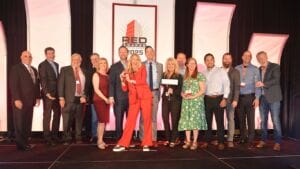This story was originally published in AZRE magazine, which was released before Phoenix Raceway announced its naming rights partnership, changing the track’s name to ISM Raceway.
Each season, thousands of roaring fans with drinks and snacks in hand, adorned from head to toe in their favorite sports memorabilia, pack into stadiums across the Valley to cheer their favorite athletes and teams on to victory while hoping to experience history in the making.

Like November 4, 2001, when over 49,000 fans witnessed Arizona Diamondbacks legend Luis Gonzalez’s game-winning, bloop-single over the head of Derek Jeter in the bottom of the ninth inning during Game 7 of the World Series at then Bank One Ballpark for the team’s first and only World Series Championship.
Before any of that can happen though, a stadium must be designed, planned and built, which is a process that gets started years before opening day. Then, it must be maintained and updated in order to stay competitive with newer stadiums in attracting other major events during the off seasons.
Whether its football, baseball, soccer, hockey or motorsports, a state-of-the-art sports venue enhances the experiences for the fans, teams, players and sponsors alike. It can also enhance the surrounding communities by creating a synergy between the new residents, companies and visitors to the area while generating nearby commercial and economic development opportunities.

A prime example is the $455.7 million, 1.7-million-square-foot, University of Phoenix Stadium completed in 2006. It’s the home of the Arizona Cardinals and annual Tostitos Fiesta Bowl, which each generate $150 million in economic impact annually, according to the stadium’s owner – the Arizona Sports & Tourism Authority.
In the past few years, it has hosted some of the largest and most publicized sporting events like two Super Bowls, two College Football Championship Games and the 2017 NCAA Final Four Tournament. The Phoenix Local Organizing Committee reports, the events hosted at the stadium since it opened 11 years ago have generated well over $5 billion in total economic impact, which includes $1.3 billion in the last three-years alone.
“Mega sporting events are a huge benefit to Arizona’s economy, generating millions in revenue and tax dollars and providing incredible national and international media exposure for our state,” explains Gov. Doug Ducey in a statement with PLOC’s findings. “And they foster community pride as residents come together to celebrate the spirit of elite athletic competition.”
Tourism is one of Arizona’s base industries, which accounted for more than 43 million visitors in 2016 that collectively spent $21.2 billion, according to the Arizona Chamber of Commerce.
“When you break that down, the sports tourism industry is a vitally important part,” says Glenn Hammer, president and CEO of the ACC. “We want a strong cultural scene and sports are a huge part of that. These major sporting events do a fantastic job of selling our state to the country and people all over the globe.”
He enjoys all of the Valley’s stadiums for different reasons because each offers something unique. However, he explains, each stadium creates a whole ecosystem of businesses around it once completed that become a magnet for more economic activity despite each stadiums’ differences.

For instance, Downtown Phoenix before the completion of Talking Sticks Resort Arena in 1992 and Chase Field in 1998 was largely seen as an eight-hour economy where most of the activity focused on work and ceased to exist after 5 o’clock when employees headed back to their homes in the suburbs.
While Downtown Phoenix’s revitalization was slow and gradual, between 2005 and 2016, the area has experienced more than $4.8 billion in investments to the areas of transportation, office, housing, education, arts, culture, sports and hospitality.
That includes the $600 million expansion of the now 880,000-square-foot Phoenix Convention Center, which hosted the 2015 NFL Experience for the Super Bowl, College Football Champ Playoff Campus in 2016 and the Final Four Fan Fest in 2017.
Hammer says, “The Suns’ and Diamondbacks’ stadiums have been a pillar for the renaissance we’ve seen in Downtown Phoenix,” which now boasts a synergistic mix of live, work, play components that’s attracting the best and brightest employees, companies and mega events.

Downtown Phoenix now has over 180 restaurants and bars, more than 3,000 hotel rooms, 800,000 square feet of retail, 8-million square feet of private office space and a public transit system connecting to the rest of the Valley.
As the Valley’s populations and the popularity of organized spectator sports grow in demand, so do money-making opportunities and the demand for large public multi-purpose facilities that can support the massive crowds and draw in major events.
The East and West Valleys are both getting in on the action, each with its own major stadium project.
In Tempe, the Phoenix Rising FC’s “pop-up” stadium was constructed as the temporary home of the United Soccer League club, but plans for a permanent, new-build stadium is pending on the club’s inclusion as a Major League Soccer expansion team.
In Avondale, a $178 million modernization project of Phoenix Raceway is currently underway to enhance amenities for fans, teams, sponsors and stakeholders.
Meanwhile, the owners and management of other stadiums in the Valley are considering whether to modernize existing stadiums or relocate and build a new one in order to stay on pace with other teams and venues nationally.
Not only does a modern stadium need to be timeless, create a sense of place, be experiential, support massive crowds, but it also needs to be easy to interface with and navigate through as well as being flexible and adaptable for multiple uses and events.
PHOENIX RACEWAY MODERNIZATION REVS UP
This past Spring, Phoenix Raceway, together with its parent company, International Speedway Corporation broke-ground on a $178 million modernization to place Phoenix Raceway as the newest, fan-friendliest and most technologically advanced entertainment venue in Arizona.
The project is a culmination of what has been years of planning, analysis and research into what sporting fans find most desirable and how to most effectively allow them to interact as spectators within the stadium environment. The result is an entirely new way for racing fans to interface with the drivers, their racing teams and the sport of NASCAR.

“In the ever-changing landscape of the sports business, you need to be able to keep pace with expectations,” says President of Phoenix Raceway Bryan R. Sperber. “There are so many choices that it becomes even more important to meet the expectations of fans and sponsors at every race.”
Originally built in 1964, Phoenix Raceway is considered the premier motorsports venue in the Southwest. In fact, it’s the only track in the West to feature two Monster Energy NASCAR Cup Series weekends a year, beginning with the Camping World 500 race in March and the upcoming Can-Am 500 race in November as well as a Verizon IndyCar Series race in April.
The transformed Phoenix Raceway will put racing in an even more exciting, new light with the modernization project that Sperber describes as “groundbreaking” and “innovative.”
With connectivity and technology becoming ever more important for fans to experience and interact with a venue through their devices, Sperber says, Phoenix Raceway will be the first and only motorsports venue in the United States with Wi-Fi connectivity throughout the entire stadium.

Other highlights include a completely redesigned infield featuring a first-of-its-kind Monster Energy NASCAR Cup Series Garage Fan Zone, placing fans face-to-face with sport’s superstars.
From musical acts to restaurants and beer gardens or interactive displays and spaces where fans will really be able to “enter the lock room,” Sperber explains, the next evolution of Phoenix Raceway will truly transform how attendees experience the venue. “It’s a way for fans to go behind the velvet rope, be a VIP, see the sport up close and have experiences that they had not been able to have before.”
“Soon we’ll have the ability to host a wide range of events from other motorsports events to other athletic events, culinary events and music festivals,” says Sperber. “Really, there’s nothing out there in terms of big events or small meetings that we wouldn’t be able to host and provide a best-in-class experience.”
The track is actively entertaining conversations regarding a variety of events and expect to have a dramatically different schedule two years from now with more events and activities.
As for development surrounding the racetrack in Avondale, Sperber says, the track has attracted some new brands that will be announced in the coming months because of the high profile nature of this project in the industry.
“Some are in the tech space, which aligns with Gov. Ducey’s vision of creating a more attractive environment to bring tech businesses to Arizona,” Sperber adds. “It goes to show that sports as an anchor can be a really powerful tool for mixed-use projects and other types of development.”
PHOENIX RISING FC ON THE FAST-TRACK
Phoenix is the largest market in the U.S. without a MLS team, but Phoenix Rising FC hopes that will change, and it will be accepted as a MLS expansion team. However, the club’s first priority was to complete a temporary stadium for this season’s games.

It only took 52-days under the direction of JLL’s Project Development Services team for crews to transform a 15.84-acre dirt lot into a full-service pop-up complex featuring a 6,200-seat soccer-specific stadium with three VIP suites, an owner’s suite, locker rooms and an adjacent, soccer-specific training field that, like the main stadium, has natural grass.
With the help of the Salt River Pima-Maricopa Indian Community, Solana Group, SRP, DLR, Kitchell and JLL, the pop-up stadium received its certificate for occupancy on March 24 and the team played its inaugural match as Phoenix Rising FC the next day.
The goal of Phoenix Rising FC — Arizona’s only professional soccer team — is to replace its pop-up facility with a permanent, climate-controlled Major League Soccer stadium at the same location by 2020. However, the USL team would need to be accepted as a MLS expansion team before construction on the stadium starts.
Phoenix Rising FC’s proposed stadium would be the centerpiece of a larger soccer complex and mixed-use development that will accommodate the Phoenix Rising FC youth soccer academy, professional and community soccer events. It’s also expected to happen alongside other key developments in the area, including a possible amusement park and a masterplan that includes high-tech office and retail space.
The club’s plan is to privately fund the stadium on the 45-acre site already under contract and in use by the club in partnership with the Solanna Group.



